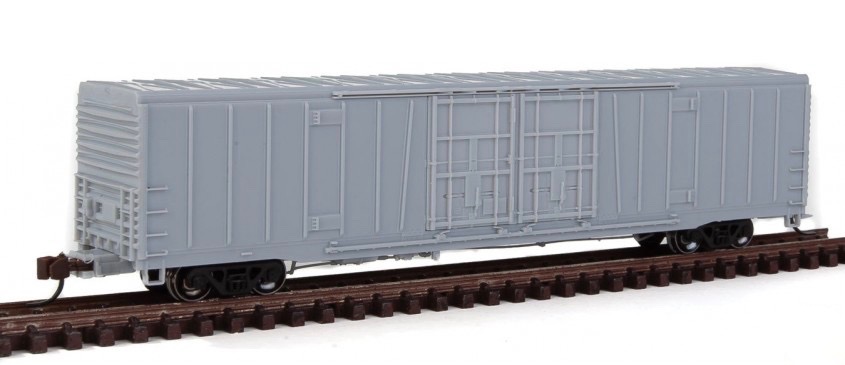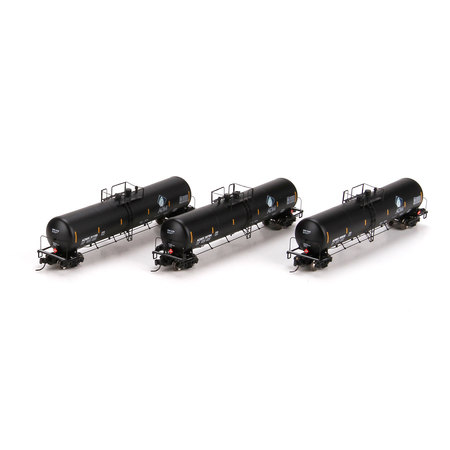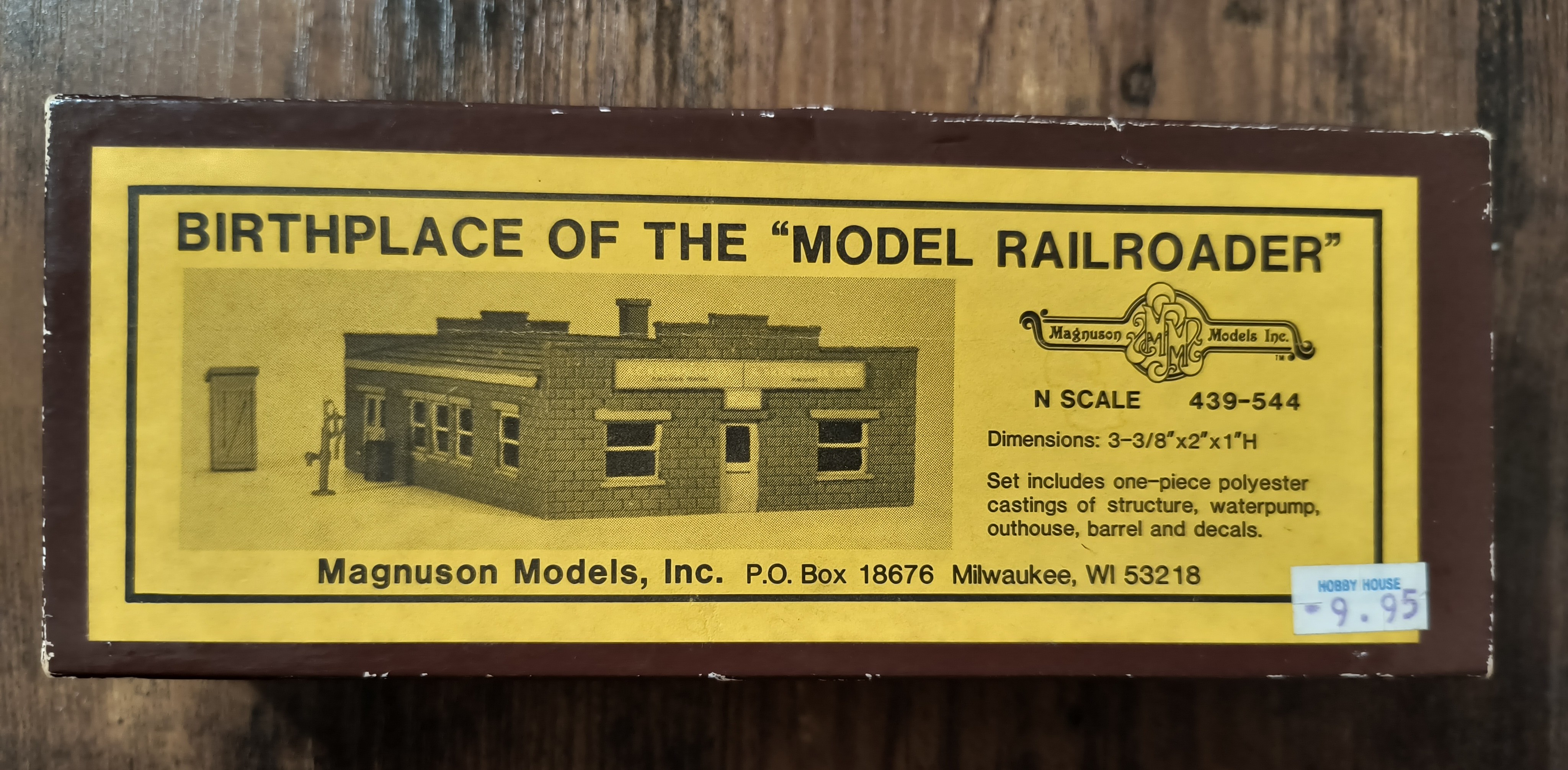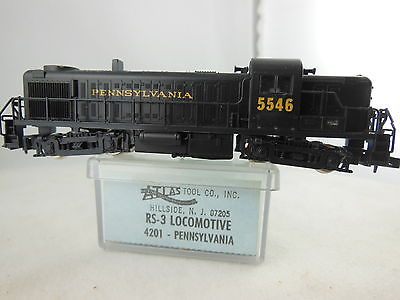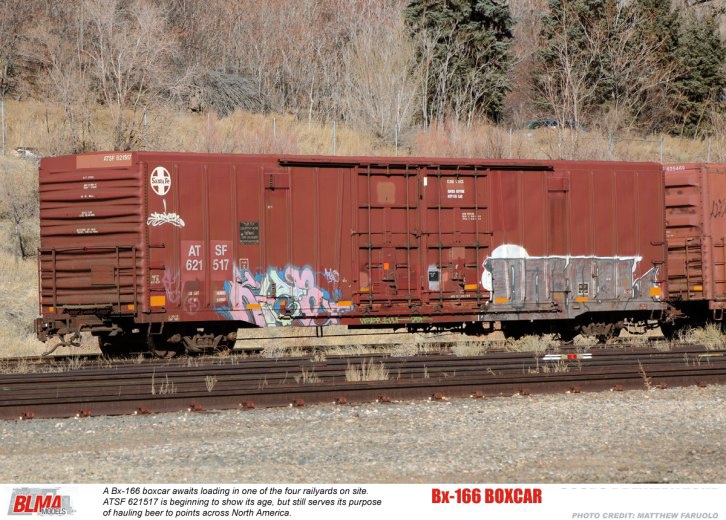Model Information: The ready-to-run models have etched metal brake wheel platforms, fine scale under body detail, and separately applied air hoses and wire cut levers.
Prototype Information: Built by the Santa Fe at the railroad's Kansas City car shops in 1974, a total of three-hundred of the 61 foot 6 inch long double 8' sliding door insulated Bx-166 boxcars were produced.
From their original Indian Red color, with large white cross logos and "Shock Control" lettering, to their mid-life, minimalist, Mineral Brown paint with small white Santa Fe logos, all the way to BNSF?s modern "Powerbar" logos, it has been reported that Bx-166's have been seen in thirteen different paint schemes.
Used for beer distribution throughout North America, some 40+ years later, re-stenciled to reflect the merged Burlington Northern and Santa Fe railroads (BNSF), a fair number of the remaining cars continue to haul beer, though many have been relegated to non-beer hauling tasks, such as the hauling of bundled corrugated and paper recyclables.
Learn more about the Bx-166 prototype and models in this BLMA You Tube video.
Prototype Information: Built by the Santa Fe at the railroad's Kansas City car shops in 1974, a total of three-hundred of the 61 foot 6 inch long double 8' sliding door insulated Bx-166 boxcars were produced.
From their original Indian Red color, with large white cross logos and "Shock Control" lettering, to their mid-life, minimalist, Mineral Brown paint with small white Santa Fe logos, all the way to BNSF?s modern "Powerbar" logos, it has been reported that Bx-166's have been seen in thirteen different paint schemes.
Used for beer distribution throughout North America, some 40+ years later, re-stenciled to reflect the merged Burlington Northern and Santa Fe railroads (BNSF), a fair number of the remaining cars continue to haul beer, though many have been relegated to non-beer hauling tasks, such as the hauling of bundled corrugated and paper recyclables.
Learn more about the Bx-166 prototype and models in this BLMA You Tube video.
Prototype History: The BX-166 was a product of Santa Fe's Topeka, Kansas shops in the late 1970s. The BX-155, BX-161, BX-166 and BX-177 were all similar designs. The BX-166 was the double plug door design and was 62 feet long. When built, they were painted in the railroad's Indian Red paint scheme with the 'Shock Control' logo on the sides. In later years, the cars were repainted in a simplified mineral red scheme. Some repainted cars had a small circle-cross herald applied in the upper left corner, while others had reporting marks only.
Many of these cars are still in service, four decades after being built. Some are used for beer service while others carry recycled paper. These cars have twoe 8-foot insulated plug doors on each side.
Many of these cars are still in service, four decades after being built. Some are used for beer service while others carry recycled paper. These cars have twoe 8-foot insulated plug doors on each side.
Road Name History:  Although they may be molded in color, unpainted and unlettered, undecorated products are marketed to modelers who seek to custom decorate their models for private roads and/or road and/or company names that were not commercially produced by any of the major manufacturers.
Although they may be molded in color, unpainted and unlettered, undecorated products are marketed to modelers who seek to custom decorate their models for private roads and/or road and/or company names that were not commercially produced by any of the major manufacturers.
Undecorated models are frequently also unassembled or only partially assembled and required modelers to be comfortable with glue, paint and sometimes solder in order to prepare their models for display. Materials for these models can vary but often include plastic, pewter and resin. Models may or may not come with decals or other decorations such as plastic signage, railings and ladders to enhance the appearance of the final product.

Undecorated models are frequently also unassembled or only partially assembled and required modelers to be comfortable with glue, paint and sometimes solder in order to prepare their models for display. Materials for these models can vary but often include plastic, pewter and resin. Models may or may not come with decals or other decorations such as plastic signage, railings and ladders to enhance the appearance of the final product.
Brand/Importer Information: In 1924 Stephan Schaffan, Sr. founded the Atlas Tool Company in Newark, New Jersey. In 1933 his son, Stephan Schaffan, Jr., came to work for his father at the age of sixteen. Steve Jr. built model airplanes as a hobby and frequented a local hobby shop. Being an enterprising young man, he would often ask the owner if there was anything he could do to earn some extra spending money. Tired of listening to his requests, the hobby-store owner threw some model railroad track parts his way and said, "Here, see if you can improve on this".
In those days, railroad modelers had to assemble and build everything from scratch. Steve Jr. created a "switch kit" which sold so well, that the entire family worked on them in the basement at night, while doing business as usual in the machine shop during the day.
Subsequently, Steve Jr. engineered the stapling of rail to fiber track, along with inventing the first practical rail joiner and pre-assembled turnouts and flexible track. All of these products, and more, helped to popularize model railroading and assisted in the creation of a mass-market hobby. The budding entrepreneur quickly outgrew the limitations of a basement and small garage operation. Realizing they could actually make a living selling track and related products, Steve and his father had the first factory built in Hillside, New Jersey at 413 Florence Avenue in 1947. On September 30, 1949, the Atlas Tool Company was officially incorporated as a New Jersey company.
In 1985, Steve was honored posthumously for his inventions by the Model Railroad Industry Association and was inducted into the Model Railroad Industry Hall of Fame in Baltimore, Maryland. In addition, Steve was nominated and entered into the National Model Railroad Association Pioneers of Model Railroading in 1995.
In the early 1990s, the Atlas Tool Company changed its name to Atlas Model Railroad Company, Inc.
In those days, railroad modelers had to assemble and build everything from scratch. Steve Jr. created a "switch kit" which sold so well, that the entire family worked on them in the basement at night, while doing business as usual in the machine shop during the day.
Subsequently, Steve Jr. engineered the stapling of rail to fiber track, along with inventing the first practical rail joiner and pre-assembled turnouts and flexible track. All of these products, and more, helped to popularize model railroading and assisted in the creation of a mass-market hobby. The budding entrepreneur quickly outgrew the limitations of a basement and small garage operation. Realizing they could actually make a living selling track and related products, Steve and his father had the first factory built in Hillside, New Jersey at 413 Florence Avenue in 1947. On September 30, 1949, the Atlas Tool Company was officially incorporated as a New Jersey company.
In 1985, Steve was honored posthumously for his inventions by the Model Railroad Industry Association and was inducted into the Model Railroad Industry Hall of Fame in Baltimore, Maryland. In addition, Steve was nominated and entered into the National Model Railroad Association Pioneers of Model Railroading in 1995.
In the early 1990s, the Atlas Tool Company changed its name to Atlas Model Railroad Company, Inc.
Item created by: Jenna on 2019-04-08 11:46:08. Last edited by CNW400 on 2020-12-02 15:12:11
If you see errors or missing data in this entry, please feel free to log in and edit it. Anyone with a Gmail account can log in instantly.
If you see errors or missing data in this entry, please feel free to log in and edit it. Anyone with a Gmail account can log in instantly.


